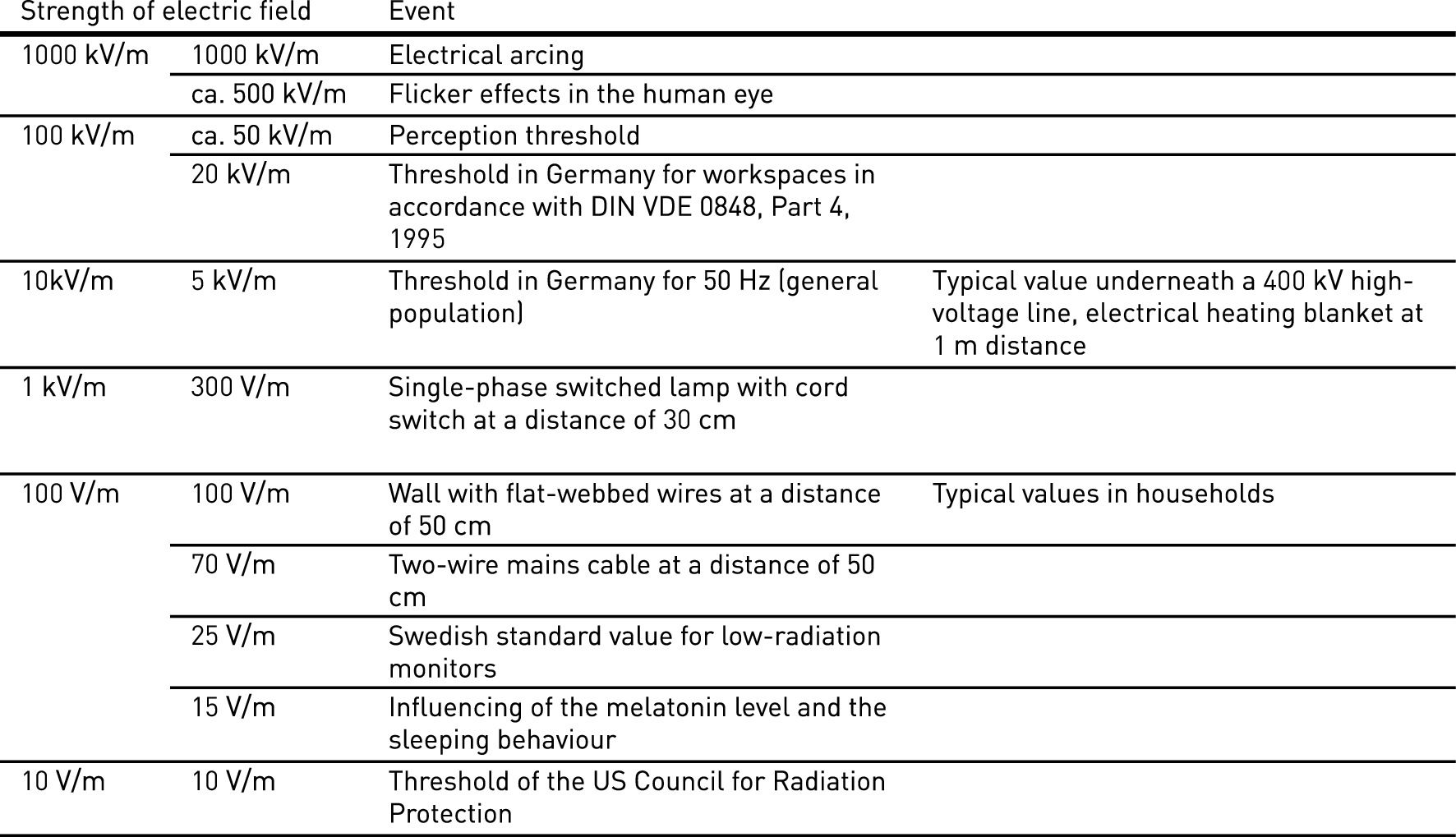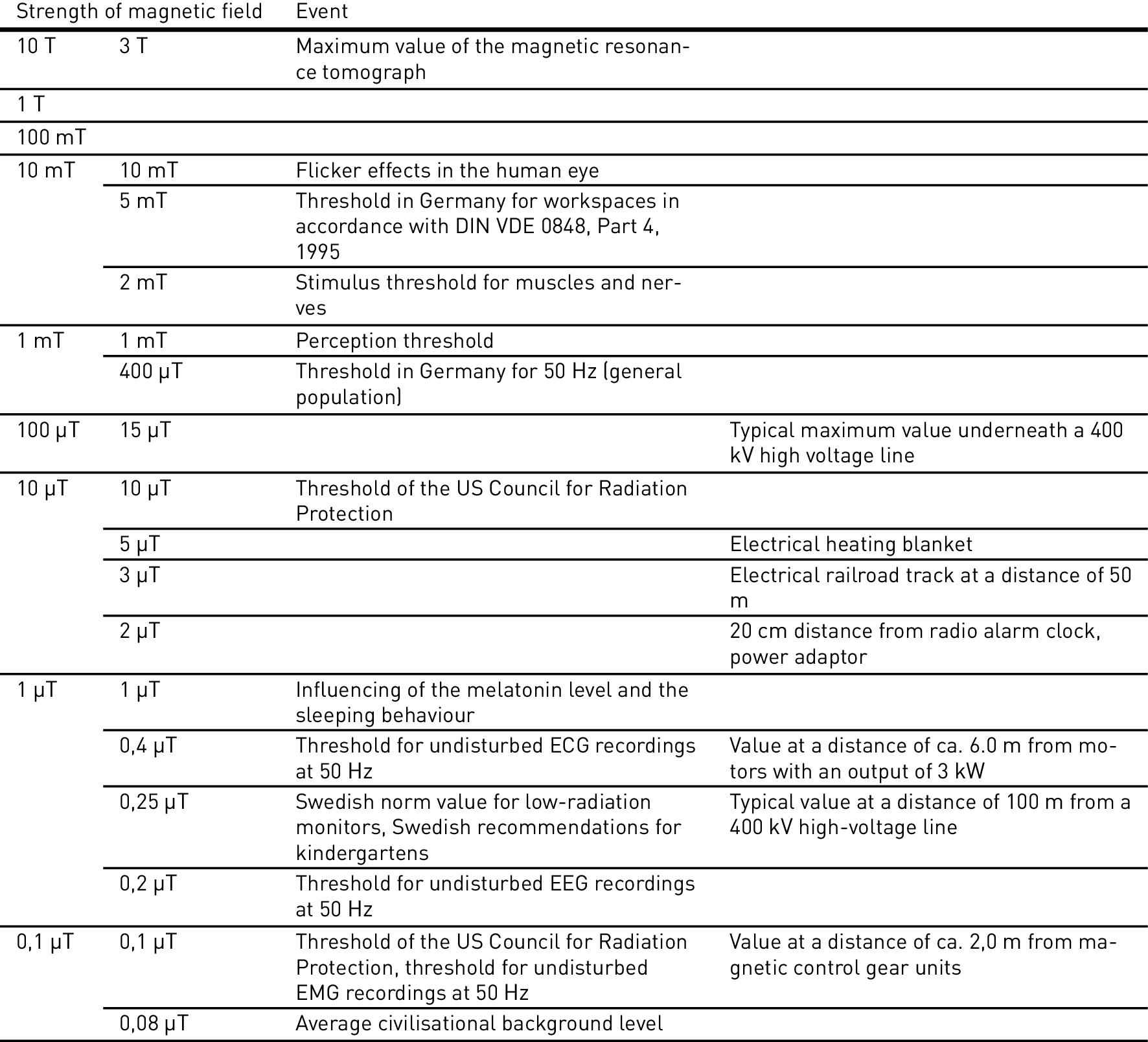Low-frequency electric and magnetic fields occur wherever electrical energy is generated, transported or applied. In everyday life, we mainly encounter electric and magnetic fields generated by power supply (50 Hz) and electrified traffic systems. Due to physical properties, effects of electric and magnetic fields can be studied separately in the low-frequency range.
Low frequency EMF
The electric field is generated by an electric tension between two conductors. Electric fields are measured in V/m (volts per meter). The most well-known instance is the electric field generated by a condenser.
Shielding from electric fields is easily achieved, e.g. by lining rooms with conductive and earthed wallpaper (Faraday cage). Due to residual moisture (conductivity) in walls and plastering, they hardly ever enter into buildings from the outside; similarly they hardly ever enter the body due to the human skin’s relatively solid conductivity, thus essentially only causing surface effects.
As a reaction to the charge present on the body’s surface, e.g. body hair is raised and vibrates at the frequency of the causative field. Most people realize this effect starting at a field intensity of 1 kV/m. When increasing field intensity to even higher values, some people additionally sense a rather unpleasant but also harmless tingling of the skin. Irritating effects due to internal shock currents can be excluded as a matter of principle.
In Germany, low-frequency EMF are covered by the "Verordnung über elektromagnetische Felder – 26. BImSchV" ("Ordinance on Electromagnetic Fields") as amended 14 August 2013. This ordinance refers to the most important installation types such as high-voltage lines, underground cables, transformers as well as railway and power supply installations. It specifies thresholds which are also contained in table and table.

Table 3.148: Examples for the exposition of low-frequency electric fields (effective values)

Table 3.149: Examples for the exposition of low-frequency magnetic fields (effective values)
The magnetic field is generated in a ring shape surrounding active conductors and decreases at increasing distance. Magnetic fields can only be passed around areas in need of protection through the use of magnetically conductive materials (shielding).
Measuring of magnetic fields H is carried out in A/m (amperes per meter); however, for the most part magnetic induction B with the measurement unit T (Tesla) has become established instead. In the air, the following applies: 1 A/m = 4 · π · 10−7 T = 1.2566 μT.
Low-frequency magnetic fields penetrate the human body and induce eddy currents, which can cause nerve or muscle irritations as well as optical flicker. The typical threshold for phenomena of this nature lies at fields of 50 Hz, and 2 mT for the most sensitive test subjects, while even extended exposure in the range between 1 mT and 20 mT have not shown any long-term consequences.
For comparison (see also table): The maximum value for mains-frequency magnetic fields at the patient's position must not exceed 4 x 10−7= 0.4 μT to facilitate interference-free registration of ECGs (electrocardiograms). These thresholds are usually met at a distance of 6 m from transformers and motors with powers of up to 3 kW (see also chapter 6.8 "Medical use rooms"). Lighting installations meet this value at a distance of ca. 1 m. Induction in patients’ occupied areas is lower than 0.1 μT. For electronic control gear, the value is even lower. A magnetic resonance tomograph generates a magnetic field of up to 3 Tesla.
Thresholds for interference-free recording of EEG (electroencephalogram) and EMG (electromyogram) signals according to DIN VDE 0100-710/EN ISO 11197 (regarding medical supply units) lie at 0.2 μT and 0.1 μT respectively.
Under the influence of weak magnetic fields, a decreased release of the sleep hormone melatonin and associated sleep disorders as well as psychological impairments (depression) were discovered.
Epidemiological studies investigating the connection between illness and fatality statistics and the ranges affecting human beings failed to show e.g. significant damage caused by high-voltage lines, particularly in terms of increased cancer risks (leukaemia, brain tumours) caused by magnetic fields.